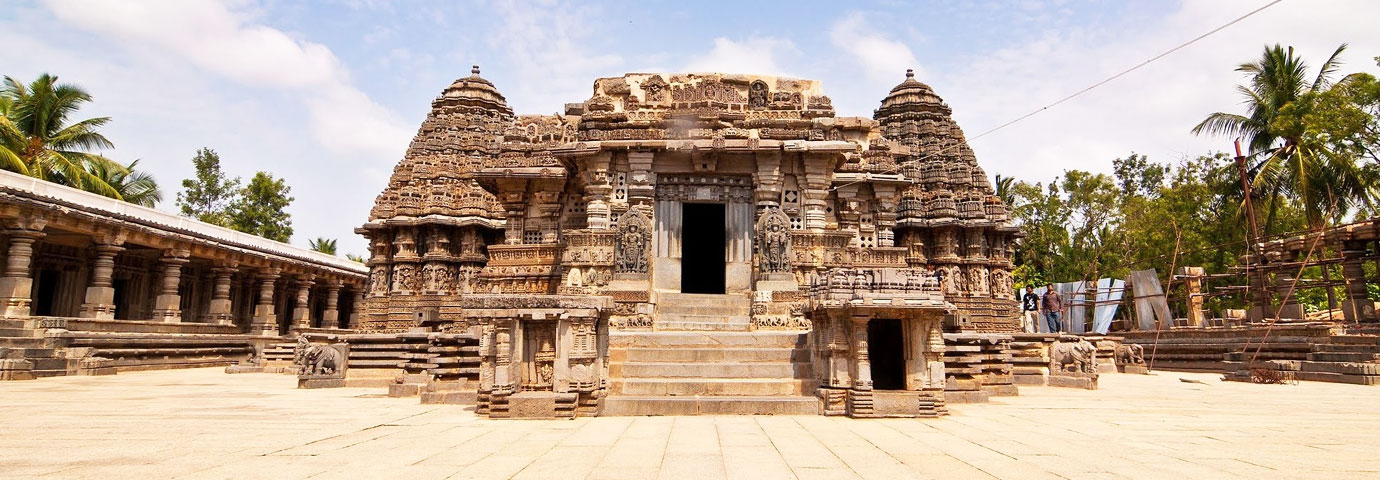History
The Prasanna Channa Kesava temple is the creation of the master architect and sculptor Jakanachari, who left his wife and son, to travel in his quest for a living and fame. Eventually, he approached the Hoysala king Vishnuvardhana, a patron of the arts, who employed him to create this marvel of a temple. The excellence of his perfect design and delicate craftsmanship became the envy of the gods who wanted to steal it. They caused the shrine to rise heavenward. Shocked and angry, Jakanachari thought that the only way he could retain the structure on the ground was to make it a little imperfect. He instantly disfigured some of the carvings on the outer walls. Once the gods found that the perfection was marred, they coveted it no longer and allowed it to sink to the ground. In the process, its traditional flagstone got dislodged from its original position and since then stands to the left of the main entrance.
The Hoysalas were a mighty marital race that ruled large parts of the present-day Karnataka between AD 1100 and 1320. They built some of the great masterpieces in temple architecture and sculpture. Their reign was noted for its peace and a leisurely life and so they were able to encourage talent of all kinds. They also encouraged a healthy sense of competition between artisans who were allowed to sign their names below their creations something unheard of before their times and this served as an incentive. The Hoysala ruler commissioned the building of temples as an act of thanksgiving after their victories in the battlefield. Victory then imbued art with incredible intricacy.
From the fine inscription on the slab at the entrance porch of the Kesava temple, we learn that Somnath, a high-ranking officer under the Hoysala king Narasimha III (AD 1254-1291) established the village as an agrahara or rent-free settlement for the people in the surrounding areas. He then named it Somnathpur after himself. He had this Vishnu temple constructed in it in AD 1268.
Tourists Attractions
The Kesava temple at Somnathpur is one of the most famous Hoysala temples in Karnataka, the two others at Belur and Halebid being equally famous. The temple built in AD 1268 is considered an example of the fully evolved style of Hoysala architecture. It is situated in the middle of a courtyard surrounded by an open veranda, which contains 64 cells. It stands on a raised platform about three feet high, which closely follows the contour of the structure and is supported at angles by figures of elephants facing outwards.
The temple is a trikutachala or three-celled, star-shaped structure, the main cell facing east and the other two, north and south respectively. All these cells are surmounted by three elegantly carved towers that are identical in design and execution. The front elevation with the three towers presents an imposing appearance and has inspired craftsmen to design silver and gold caskets on this model.
The outer walls of the temple have a number of railed parapets running the whole way round the shrine. They contain, beginning from the bottom, running friezes of beautiful sculptures of caparisoned elephants, charging horsemen, swans, mythological beasts and scrolls. Besides, there are more running friezes depicting themes from the Indian epics, the Ramayana, the Mahabharata and the Bhagavata Puranas. There are turreted niches with small images of lions separating them. Above them and below the eaves are perforated screens.
The outer walls are an art connoisseur's delight. They contain elaborately carved sculptures of Vishnu and other deities-as many as 194 idols, of which 114 are female figures. The gods and goddesses of the Hindu pantheon are represented by the majority of figures of Vishnu and his many incarnations such as Narasimha, Varaha, Hayagriva and Venugopala. There are also elegantly sculptured figures of Brahma, Shiva and Indra seated on the elephant Airavata. There is an exceptionally beautiful figure of Saraswati, the goddess of learning and of Durga as Mahishasuramardini.
A unique feature of the Kesava temple like all other Hoysala temple, is the fact that the images on the outer walls bear on their pedestals the names of the sculptors who carved them, like Mallitamma, Baleya, Choudeya and Yelamasaya. Forty sculptures bear the name of Mallitamma alone and, he must have been the master craftsman. These signed works of art glow with elaborate ornamentation very characteristic of Hoysala sculptures. Many sculptors, equally skilled and even more renowned, have preferred anonymity of authorship. It is noteworthy that nowhere in the temple do we find the name of the legendary Jakanachari, the man who is supposed to have constructed the temple. It is the opinion of many scholars that there was no master builder by the name of Jakanachari.


